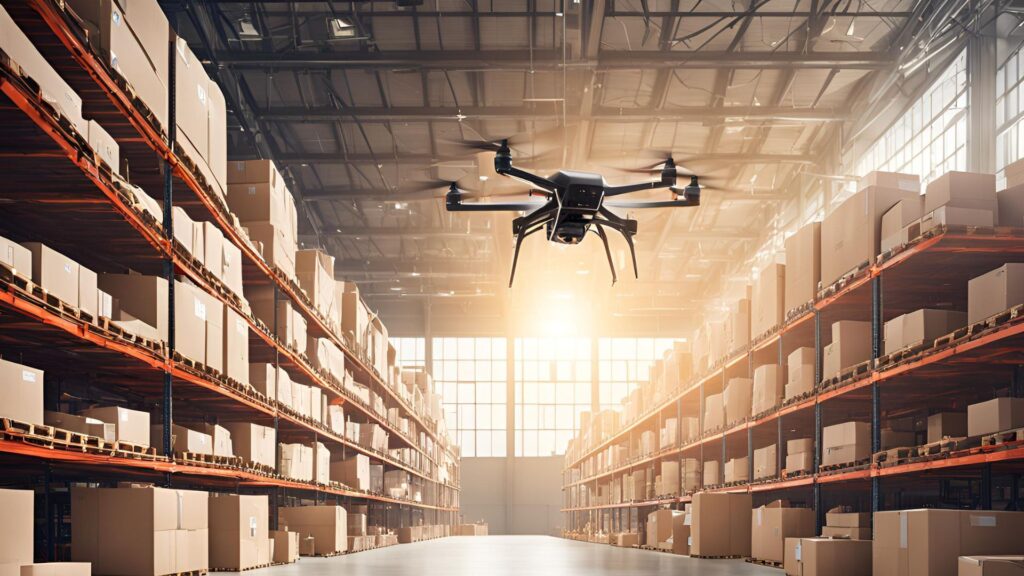Do Drones have a Future in Warehouses?
The logistics and supply chain industries are undergoing a technological transformation, with warehouses at the forefront of this change. There is much talk about usage of drones in warehouse operations. While there are several use cases that can be imagined for solving using drones, the challenges and limitations of the technology and the use case determine the feasibility.
Here is a short summary of use cases, benefits, challenges and outlook on feasibility
| Use Case | Benefit | Challenge | Feasibility |
| Inventory Scanning | Faster and more accurate stock counting using RFID or barcode scanning. | Line-of-Sight Limitation: Barcodes must be visible to the drone’s camera, which can be obstructed by packaging or other items.Limited battery life.Difficulty in scanning reflective or damaged barcodes. | Medium |
| Stock Audits | Real-time auditing of inventory to ensure accuracy and reduce shrinkage. | Requires seamless integration with WMS.Signal interference in warehouses with poor connectivity. | Medium |
| Item Location Tracking | Quickly locate misplaced or hard-to-find inventory items. | Requires precise indoor positioning systems.Error margins are high in cluttered or dynamic spaces. | Low |
| Infrastructure Inspection | Inspect racks, shelving, and high ceilings without manual intervention. | Limited camera resolution for detailed inspections.Risk of collisions in tight spaces. | High |
| Surveillance and Security | Monitor unauthorized activity or potential hazards. | Privacy concerns.Navigating crowded or dynamic environments during operations. | Medium |
| Picking and Packing Assistance | Transport lightweight items between zones to reduce travel time for workers. | Low payload capacity.Risk of damaging items or disrupting workflow. | Low |
| Emergency Response | Deliver medical kits or extinguishers to accident spots quickly. | Requires pre-defined emergency protocols and training for effective deployment. | High |
| Thermal Monitoring | Detect temperature anomalies in cold storage or areas prone to overheating. | Requires specialized thermal cameras.Limited use cases outside niche requirements. | Medium |
| Cycle Counting | Perform periodic stock counts without halting operations. | Line-of-Sight Limitation: Similar to inventory scanning, barcodes need clear visibility.Scalability issues for larger warehouses. | Medium |
| Intra-Warehouse Transport | Transport documents, tools, or lightweight packages across zones. | Payload limitations.Potential disruptions in worker-heavy zones. | Low |
So, Are Drones Just a Dream?
Not quite! While the adoption is slow, there are promising signs of progress:
Inventory Management: Some warehouses are using drones for scanning inventory in hard-to-reach areas, reducing the need for manual labor.
Real-Time Audits: Drones equipped with RFID and camera technologies can provide faster and more accurate stock audits.
Last-Mile Delivery: Though not within warehouses, drones are revolutionizing the way we think about last-mile logistics.
The Road Ahead
To make drones a warehousing reality, we need:
- Advances in drone technology for better payload capacity and battery life.
- Clearer regulations and safety protocols.
- Cost-effective solutions tailored for warehouses of all sizes.
- Open-mindedness and willingness to innovate from industry leaders.
The idea of drones in warehousing might still be distant, but it’s not unattainable. With the right mix of innovation, regulation, and adoption, the buzz of drones in warehouses might one day become as common as the hum of forklifts.
What do you think? Are drones the next big thing in warehousing, or just another tech buzzword waiting for its moment? Let’s discuss in the comments!

